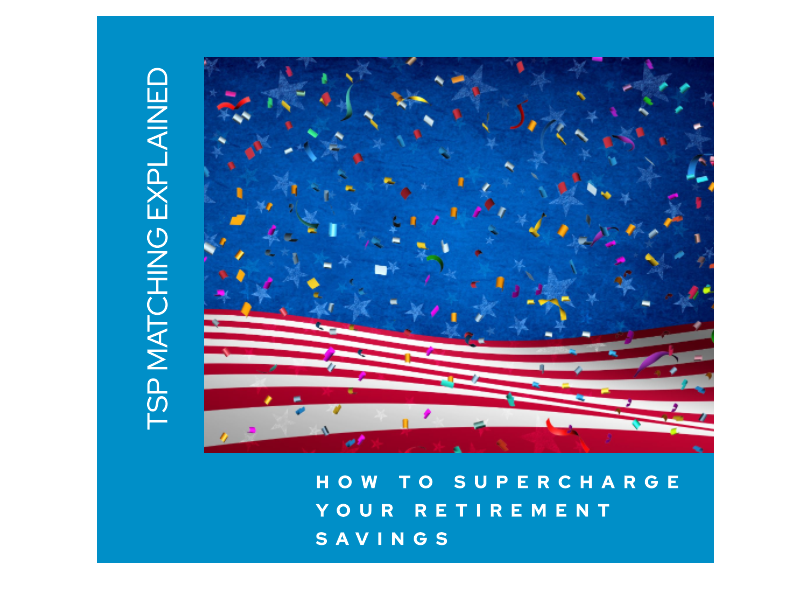The Thrift Savings Plan (TSP) is a vital retirement savings vehicle for federal employees and members of the uniformed services in the United States. One of the key benefits of the TSP is the matching contributions offered by the government. Understanding how the TSP matches contributions can help you make informed decisions about your retirement savings strategy and maximize your financial security in your post-working years.
What is the TSP?
The TSP is a retirement savings plan designed to allow federal employees and military personnel to save for retirement with tax advantages. It operates similarly to a 401(k) plan in the private sector. Employees can contribute a portion of their salary to the TSP, and these contributions are invested in various funds to grow over time. Learn more about ways to invest in the TSP on our TSP & Investing page.
How Does TSP Matching Work?
You may have heard you get a 5% match on your TSP contributions. However, it is not a dollar-per-dollar match for the entire 5%. Here’s a breakdown of how the matching works. Note that for Federal Employees, pay is your base + locality pay. For service members, the match is only on your base pay; allowances are not part of the calculation.
Agency/Service Automatic (1%) Contribution:
The government automatically contributes 1% of your basic pay into your TSP account, even if you do not make any contributions yourself. That means everyone gets 1% of your pay added to the TSP.
Agency/Service Matching Contributions:
The government will match your contributions into the TSP, dollar for dollar, for the first 3% of your pay that you contribute. For the next 2% of your basic pay that you contribute, the government will match you at a rate of 50 cents on the dollar.
In total, if you contribute 5% of your basic pay, you will receive the full 5% match from the government.
For example, if your pay is $50,000 and you contribute 5% ($2,500) to your TSP account, the government will contribute an additional $2,500, bringing your total TSP contributions for the year to $5,000. That is a 100% return on any money you contribute into the TSP.
Maximizing the TSP
To make the most of the TSP matching contributions, consider the following strategies:
Contribute at Least 5%: To maximize the government match, contribute at least 5%. This ensures you receive the full 5% match and fully utilize the employer contribution. For more insights, see our guide on whether you should contribute more than TSP match.
Start Early: The power of compound interest means that the earlier you start contributing to your TSP, the more you’ll save for retirement. Even small contributions can grow significantly over time.
Consider Roth: Roth contributions will not lower your current year’s income. However, they may provide you with tax-free growth and distribution at retirement. Learn more in our guide on securing your financial future with a Roth 401(k).
Increase Contributions Over Time: As your income grows or you receive pay raises, consider increasing your TSP contributions. Gradually increasing your contributions can help you reach your retirement savings goals faster.
Diversify Your Investments: The TSP offers five investment funds. Diversify your investments to spread risk and potentially increase returns over the long term.
Caution! Spread Out Your Contribution for the Entire Year
Failure to spread your contribution over the entire 26 pay period means you will miss out on TSP matching contributions.
One of the most significant nuances of the TSP is that matching contributions will only occur on a pay period when you contribute. This creates a unique issue if you are maxing out your TSP. I have met many federal employees who over-contribute to complete the TSP maximum by October or November. The rationale is that they want to max out the TSP and use the larger paycheck at the end of the year to assist with holiday expenses. What they don’t realize is that since they are not contributing to the TSP in the last few pay periods, they are not getting the Agency Matching Contributions. Essentially, they cut themselves off from the 4% match they are entitled to. For more pitfalls to avoid, check out common TSP misconceptions and mistakes.
Conclusion
Understanding how the TSP matches contributions is essential for federal employees and military personnel looking to secure their financial future. You can build a substantial retirement nest egg by contributing at least 5% of your pay and taking advantage of the government’s matching contributions. Start early, be consistent, use Roth, and consider increasing your contributions over time to maximize the benefits of the TSP and enjoy a comfortable retirement.
Reach Out to Us!
If you have additional federal benefit questions, contact our team of CERTIFIED FINANCIAL PLANNER™ (CFP®), Chartered Federal Employee Benefits Consultants (ChFEBC℠), and Accredited Investment Fiduciary (AIF®). At PlanWell, we focus on retirement planning for federal employees. Learn more about our financial advisor for federal employees approach and discover our process designed for the career federal employee.
Preparing for federal retirement? Check out our scheduled federal retirement workshops. Sign up for our no-cost federal retirement webinars through our online workshop portal. Make sure to plan ahead and reserve your seat for our FERS webinar, held every three weeks. Want to have PlanWell host a federal retirement seminar for your agency? Reach out, and we’ll collaborate with HR to arrange an on-site FERS seminar.
Want to fast-track your federal retirement plan? Skip the FERS webinar and start a one-on-one conversation with a ChFEBC today. You can schedule a one-on-one meeting on our contact page.
References:
https://www.tsp.gov/making-contributions/
https://www.military.com/money/personal-finance/dont-lose-out-tsp-matching-funds.html










